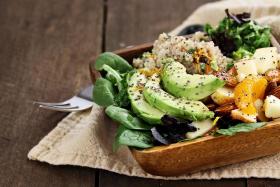According to figures from Public Health England (PHE), most Brits aren’t getting enough fiber from their diets.
Findings from the latest National Diet and Nutrition Survey reveal that the average Brit consumes 18g of fiber each day, however, this is significantly below the recommended intake of 30g.
So, where are we going wrong? And why does it matter?
Fiber is a crucial component of any diet: aiding digestion, preventing constipation, and lowering your risk of heart disease, according to the NHS.
It’s also associated with a lower risk of stroke, type two diabetes, and bowel cancer.
Plus, eating fiber-rich foods can make us feel fuller between meals and could, therefore, be conducive to sustainable weight loss.
Despite its importance, there are myriad misconceptions surrounding fibers, from how much we need to where we can get it from.
According to Healthista, these are some of the most common myths:
Fiber is best sourced from cereals and beans
When you hear the word fiber, the first thing to spring to mind might well be a bowl of dry cereal or breakfast biscuits, items that are often lauded in advertising campaigns for their supposedly high fiber content.
However, such threats are often also loaded up with sugar, subsequently reducing their nutritional value.
Healthier alternatives to fiber-rich foods include whole grains, such as oats and barley, nuts, and complex carbohydrates like sweet potato.
It’s tough to ensure children are getting enough
According to the NHS, children between the ages of 11 and 16 need approximately 20g of fiber per day – which is slightly more than what the average British adult consumes.
Given that fiber is typically high in healthier foods that aren’t usually favored by children, many parents may struggle to ensure their kids are getting enough.
However, there are a number of child-friendly snacks that parents can provide, Singh suggests, such as carrot sticks and wholemeal pitta bread.
There’s only one type of fibers
The terms soluble and insoluble fiber might sound familiar, but what do they actually mean?
While soluble fiber is available in oats, beans, and lentils, its insoluble counterpart is available in wheat bran, whole grains, and certain vegetables. The former may lower the risk of heart disease while the latter enables food to pass more quickly through the intestines.
Both are of equal importance in terms of supporting the digestive system, however, you don’t need to worry too much about which one you’re consuming as fiber-rich foods will typically contain both.
All fruits and vegetables are good sources of fibers
While all fruits and vegetables contain fiber, some boast a higher content than others.
According to Singh, the best sources include broccoli, peas, and kiwi fruits.
Leaving the skin on some products can also boost fiber content, he added, which can easily be done for root vegetables, cucumbers, and radishes.
You’re already eating enough
As the aforementioned data shows, a lot of Brits aren’t getting as much fibers as they should be.
Some easy ways to rectify this, as suggested by Dr. Ranj Singh, could be by making a few food swaps.
Switching from cashews to almonds could add 1g to your daily fibers intake, says Singh. While choosing grapes instead of strawberries could almost double your fiber levels.
Other suggestions made by the TV doctor include going from
- cereal to overnight oats;
- raisins to dates
- and apple sticks to carrots.

